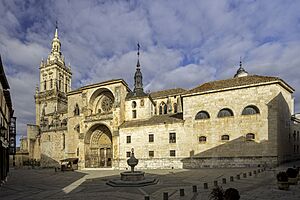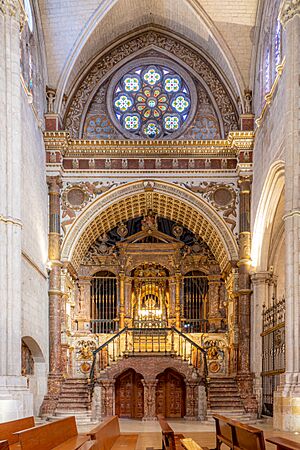Burgo de Osma Cathedral facts for kids
Quick facts for kids El Burgo de Osma Cathedral |
|
|---|---|
| Cathedral of the Assumption of Mary | |
| Catedral de la Asunción de María | |

South façade and tower
|
|
| 41°35′08″N 3°04′16″W / 41.585629°N 3.071°W | |
| Location | El Burgo de Osma |
| Country | Spain |
| Denomination | Catholic |
| History | |
| Status | Cathedral |
| Dedication | Assumption of Mary |
| Dedicated | 1272 |
| Architecture | |
| Style | Gothic, Baroque, Neoclassic |
| Years built | 1232 - 1784 |
| Specifications | |
| Tower height | 72 m (236 ft 3 in) |
| Administration | |
| Metropolis | Burgos |
| Diocese | Osma-Soria |
The Cathedral of the Assumption of Mary is a beautiful Roman Catholic cathedral found in El Burgo de Osma, a town in Spain. This amazing building was constructed in the Gothic style, which was popular for churches and castles in the Middle Ages. It was built on the same spot where an older Romanesque church once stood.
The cathedral is one of the best-preserved medieval buildings in Spain. Many people consider it a top example of Gothic architecture from the 1200s. Building the main church started in 1232 and finished in 1784. The peaceful cloister, a covered walkway, was added in 1512. The tall tower, which is 72 meters (about 236 feet) high, was completed in 1739.
Cathedral Museum
The cathedral has a museum that displays many interesting pieces of religious art. One special item is a very old book called a Commentary on the Apocalypse. This book was made in 1086, making it over 900 years old!
The Shroud of San Pedro de Osma
The Shroud of San Pedro de Osma is a truly magnificent piece of silk from the 1100s. It measures about 50 by 43 centimeters (about 20 by 17 inches). This special cloth was discovered inside the tomb of San Pedro de Osma, a bishop who passed away in 1109. It was used to wrap his bones during his burial.
The silk shroud is decorated with gold threads and has many cool designs. You can see inscriptions, round shapes called roundels, and mirrored images of lions with harpies on their backs. There are also griffins standing next to kneeling men. The silk even has a special mirrored writing style called muthanna, which means "doubled" in Arabic. The writing, found in the smaller roundels, says: “This is among the things made at Baghdad, may God protect it!”
Even though the inscription says the silk was made in Baghdad, some clues suggest it was actually made in southern Spain. For example, the way some words are spelled in the inscription points to western Islamic lands. Also, the unique way the fabric was woven and how the gold thread was put in are more typical of textiles made in the west. The shroud's specific weave pattern also suggests it came from Spain.
Because of these clues, many experts believe that the shroud was made in southern Spain. It seems that during the 1000s and 1100s, it was common in Spain to create designs that looked like Islamic art and even claim they were from Islamic places.
Today, the Shroud of San Pedro de Osma is part of the collection at the Museum of Fine Arts, Boston. It was bought by the museum in 1933.
Images for kids
See also
 In Spanish: Catedral de la Asunción de la Virgen (El Burgo de Osma) para niños
In Spanish: Catedral de la Asunción de la Virgen (El Burgo de Osma) para niños










